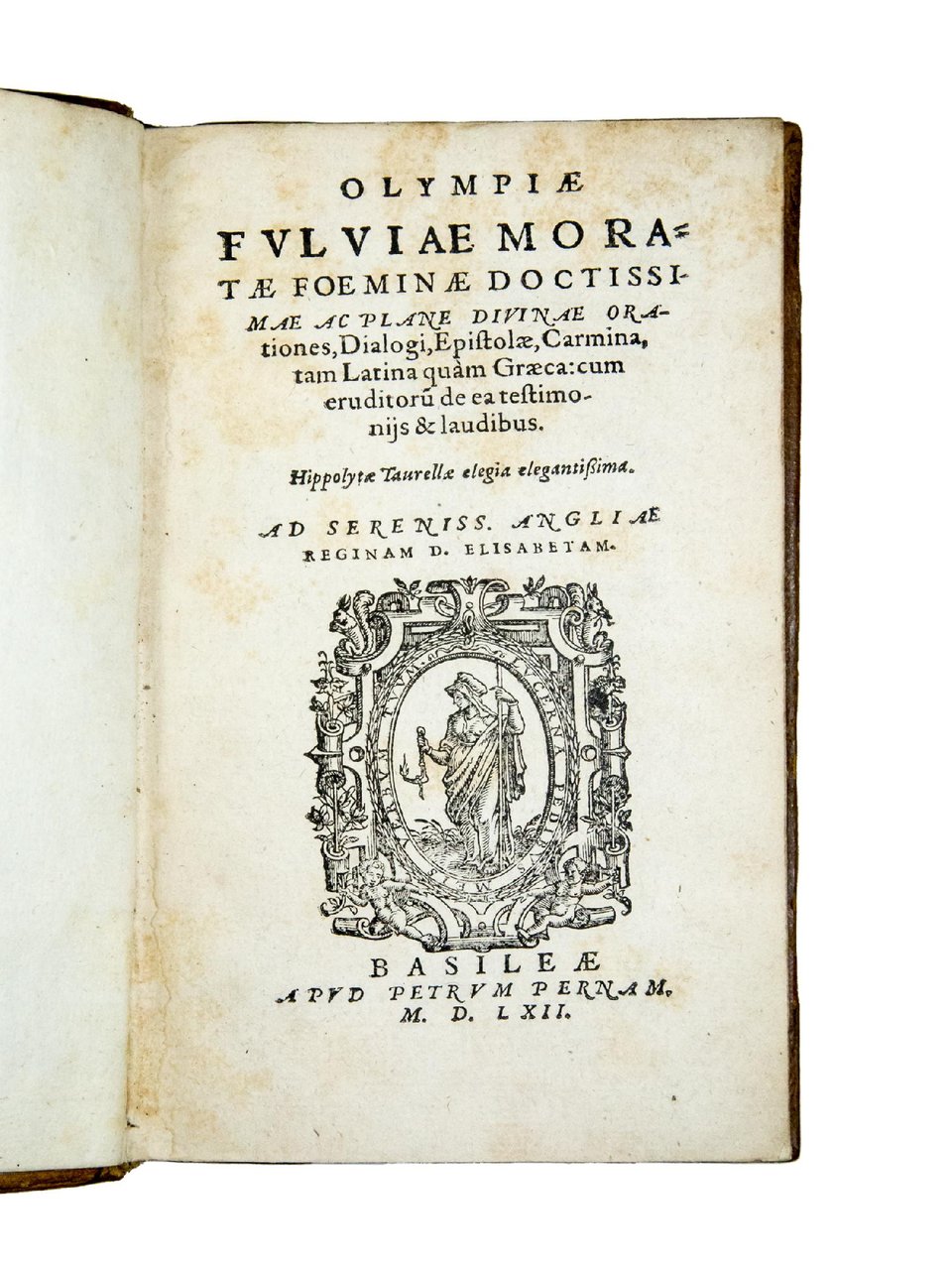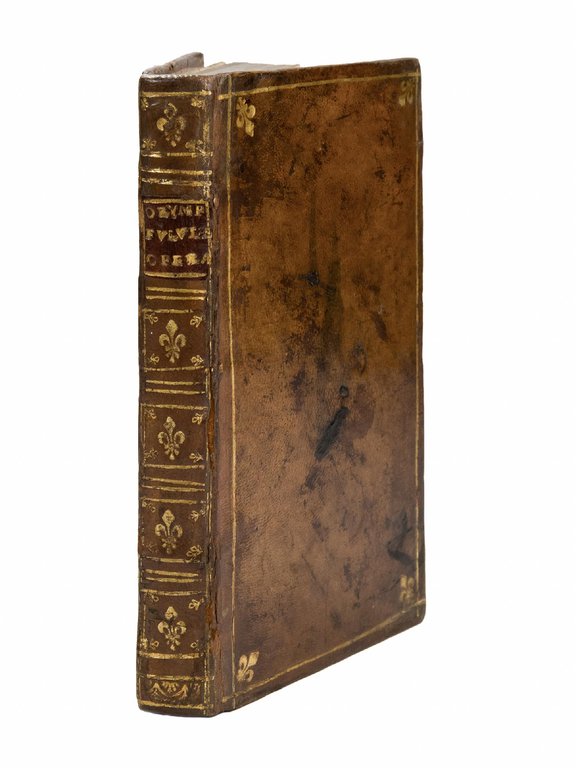

Libri antichi e moderni
MORATA, Olympia Fulvia (1526-1555)
Orationes, Dialogi, Epistolae, Carmina, tam Latina quàm Graeca: cum eruditoru(m) de ea testimonijs & laudibus. Hippolytae Taurellae elegia elegantissima. Ad Sereniss. Angliae Reginam D. Elisabetam
Petrus Perna, 1562
5000,00 €
Govi Libreria Antiquaria
(Modena, Italia)
Le corrette spese di spedizione vengono calcolate una volta inserito l’indirizzo di spedizione durante la creazione dell’ordine. A discrezione del Venditore sono disponibili una o più modalità di consegna: Standard, Express, Economy, Ritiro in negozio.
Condizioni di spedizione della Libreria:
Per prodotti con prezzo superiore a 300€ è possibile richiedere un piano rateale a Maremagnum. È possibile effettuare il pagamento con Carta del Docente, 18App, Pubblica Amministrazione.
I tempi di evasione sono stimati in base ai tempi di spedizione della libreria e di consegna da parte del vettore. In caso di fermo doganale, si potrebbero verificare dei ritardi nella consegna. Gli eventuali oneri doganali sono a carico del destinatario.
Clicca per maggiori informazioniMetodi di Pagamento
- PayPal
- Carta di Credito
- Bonifico Bancario
-
-
Scopri come utilizzare
il tuo bonus Carta del Docente -
Scopri come utilizzare
il tuo bonus 18App
Dettagli
Descrizione
Adams, M-1742; VD 16, M-6287; O. Morata, The Complete Writings of an Italian Heretic, H.N. Parker, ed., (Chicago, IL, 2003), pp. 84-177; D. Pirovano, Le edizioni cinquecentine degli scritti di Olimpia Fulvia Morata, in: “Le varie fila. Studi di letteratura italiana in onore di Emilio Bigi”, (Milano, 1997), pp. 101-102.
SECOND, GREATLY ENLARGED EDITION published by the Italian emigrant scholar Celio Secondo Curione (1503-1569) with a new dedication to Queen Elizabeth of England, dated Basel, September 1, 1562.
The first edition was published in 1558 and contained thirty letters by and to Morata as well as some letters by others. In the present edition the number of letters was raised to 74, of which 50 were by Morata, 14 to her and 10 by others. In the third edition (1570), which was reprinted in 1580, two Italian letters by Morata were added.
The volume contains furthermore a declamation on Cicero's Stoic Paradoxes and another In Praise of Mutius Scaevola (the latter in both Greek and Latin), a Latin translation of the first two stories of Boccaccio's Decameron, two dialogues in Latin, eleven poems (eight in Greek and three in Latin), and the translation into Greek of seven Psalms, as well as several poems in Greek and Latin in her praise and some epitaphs (cf. O.F. Morata, Briefe, R. Kössling, ed., Leipzig, 1990, pp. 215-216).
At the end of the volume is printed the famous letter in form of an elegy variously attributed to Ippolita Torelli (1499-1520), wife of Baldassarre Castiglione, who was one of the most influential representatives of courtly culture in Italy and author of the Courtier (1528). This poem was first included in his Latin poetry as by himself. It was written in 1518, when Baldassarre was ambassador to the Gonzaga at Rome. In it she laments his absence from home and calls his attention to the dangers of the court of Leo X. She mentions as a great comfort the portrait Raphael had painted of him. Added is also her epitaph by Pietro Bembo, which is found on her tomb in the Santuario delle Grazie near Mantua (cf. J.D. Falvo, The Economy of Human Relations: Castiglione's ‘Libro del Cortegiano', New York, 1992, pp. 159-166).
“Es ist eine bunte Vielfalt von Begegnungen und Verbindungen zwischen italienischen sowie deutschen und in einem Falle auch schweizerischen Gelehrten, die sich in Olympia Moratas Korrespondenz widerspiegelt. Diese gründete im wesentlichen auf der Gemeinsamkeit Renaissance-humanistischer Bildung und - mehr oder weniger ausgeprägt - auf reformatorischer Glaubenshaltung. Möglicherweise hatte der deutsche Dichter Goethe auch diese Kontakte im Blick, als er unter dem 30. Januar 1828 in seinem Tagebuch notierte: ‘Las in den Briefen der Olympia Fulvia Morata, und es ging mir über den eigentlichen, damaligen, protestantischen Zustand ein ganz neues Licht auf. Meine Bemerkungen denke niederzuschreiben' ” (R. Kössling, Die Korrespondenz der Olympia Fulvia Morata (1526-1555) als Dokument italo-deutscher Begegnungen, in: “Acta Conventus Neo-Latini Bariensis”, Tempe, AZ, 1998, p. 377).
Celio Secondo Curione was born the youngest of twenty three children in Moncalieri in the province of Turin. He first studied law and humanities at Turin and continued his studies in Milan, where he also started to teach in 1528. He became more and more interested in the writings of the German reformers. He taught at Pavia and Venice, where he met Bernardino Ochino. He lived for a short time at the court of Ferrara and in Lucca. After several narrow escapes from the Inquisition he fled to Switzerland via the G

